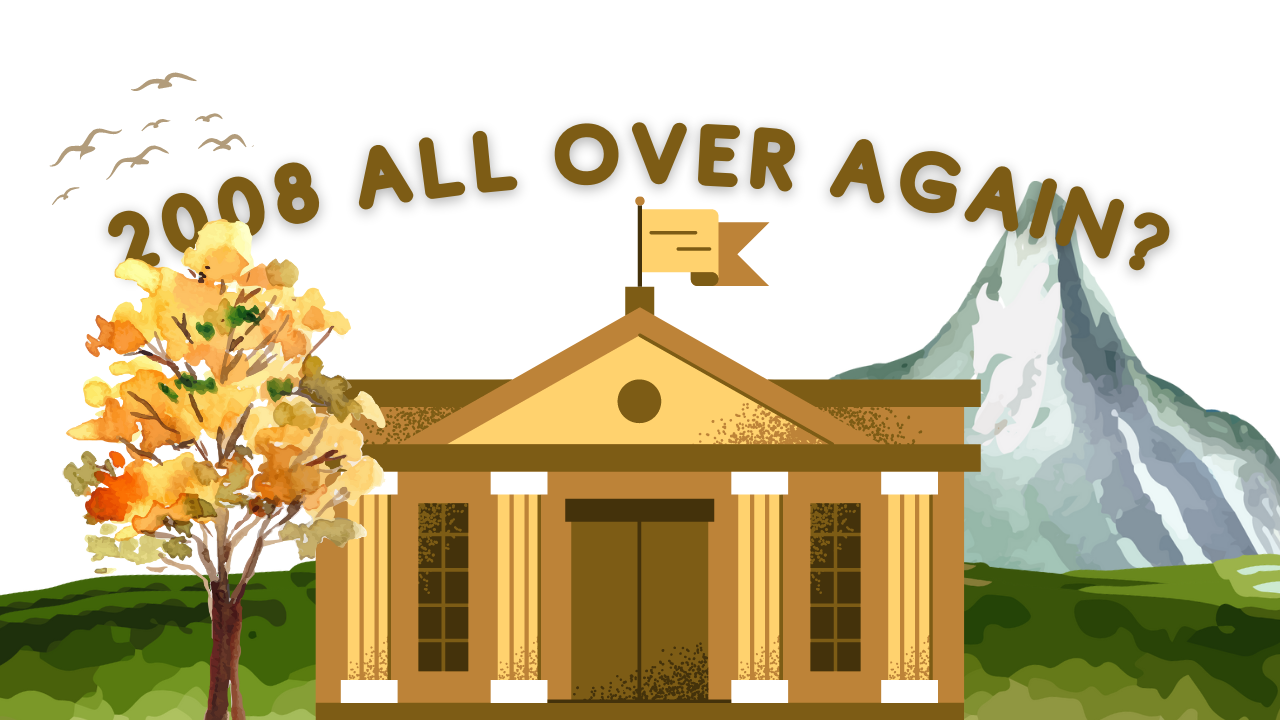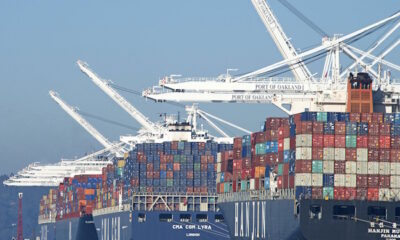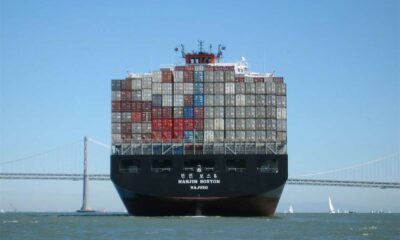Executive
Is it 2008 all over again?
Short answer: no, because the 2008 dynamics are not present. But unlimited deposit insurance puts the big players at moral hazard.

Hello, this is Darrell Castle with today’s Castle Report. This is Friday the 17th day of March in the year of our Lord 2023. I will be talking about the collapse of the Silicon Valley Bank (SVB) which was taken over by federal regulators on Friday March 10th. Signature Bank was shut down as well on Sunday, March 12th because of “similar systemic risk” to SVB. Is it 2008 all over again, and are we looking at another systemic collapse of the banking system unless there is a federal bailout?
Why did SVB fail?
SVB was the 16th largest bank in the country and its collapse was the 2nd largest after Washington Mutual in 2008. Does that mean that we are in 2008 all over again? The short answer is no, I don’t believe it does according to everything I have been able to learn from my research into both 2008 and now. However, Swissbanc is in trouble and would reportedly have failed without assistance from other Swiss banks, and Goldman Sachs this morning reported what the bank called “cracks in the system.”
So, what happened to SVB which was known to be the go-to bank for tech start ups especially in the green energy segment. Forbes Magazine had just praised the bank and named it a member of the top 100. SVB grew very quickly from a deposit base of $55 billion in 2020 to $220 billion at the time of its collapse. Its base of borrowers was small and didn’t need to borrow that much money, so the bank started investing the money from depositors and with rates low they had to take risks to get a return. Its investments were long term, about 10 years, its deposits were subject to instantaneous withdrawal. The value of its investments fell dramatically with the FED’s rapidly increasing interest rates until SVB could not cover its $162 billion in losses.
SVB’s failure is not a 2008 event, because…
SVB held $27.7 billion in derivatives which is not a small sum, but JP Morgan, by comparison, holds $55.387 trillion in derivatives making it the largest derivatives bank in the entire casino. SVB’s fall is not, then, a threat to the entire banking system as happened in 2008, or at least that is what I have determined from my research. The federal government will simply rob the rest of us to make good the losses. Oh they will say the charges go to other banks, but eventually it makes its way to the bottom of the pyramid. The people on the point of the pyramid are covered for their excesses by the mass at the bottom.
How is SVB different from 2008 which was a systemic threat to the entire system. In 2008 the entire banking system had spent about 3 years investing in what came to be called mortgage-backed securities. Just mortgages bundled together and sold as security. Rates were low and credit fueled the economy, especially mortgages, but when the economy started a downturn and people lost their jobs they just walked away from all those mortgages.
How the mortgage racket blew up in the FED’s faces
The FED was engaged in lowering interest rates to very low numbers which caused massive inflation in the housing and derivatives bubbles. The FED then attempted to let a little air out of the bubble which caused cracks in the entire system. The entire credit system of the country, especially the one based on mortgage financing, began to collapse. Banks from the smallest to the largest had at least some part in the scheme because there was just too much money to be made for any banker to resist.
Mortgages were sold to subprime borrowers by the millions which means people borrowed the money to buy houses they had no ability to pay for. Many of those deals were on an adjustable-rate basis meaning that at some point there was a large bubble payment due or else the mortgage had to be refinanced at a much higher interest rate. The higher rate often put the monthly payment out of the reach of many homeowners, and they simply walked away from the home and left it setting there empty.
In 2008 the big New York banks were holding the bag
The large New York Banks like Lehman Brothers were left holding what their CEO referred to as the largest pile of odorous excrement in the history of capitalism. Most of the large banks went to the SEC and said we are bankrupt if you don’t help us and provoking a depression is not a good point on the resume of a presidential candidate. Lehman Brothers, however, did not take that course. Instead, they tried to sell all that odorous excrement before anybody noticed. The result of all that maneuvering was that the Feds bailed out everybody except Lehman Brothers, which went into bankruptcy and was closed.
Large depositors then, sensing danger, simply withdraw funds, leaving those less aware at the mercy of the bank and the FDIC. The FDIC insures deposits up to $250,000 but many businesses have payroll deposits more than that amount and if deposits are seized, business can’t pay their workers or other bills. This all adds up to an excellent way of provoking bank runs as well as collapsing surrounding business which depend on revenue safely deposited into an FDIC insured bank.
The FED will let inflation continue
One other thing that seems certain to happen as a result of all this is that inflation will be allowed to run on since the Federal Reserve will be forced to halt its interest rate increases. The FED may very well be faced with a dilemma, which I argue, it created. It can continue to raise rates and curtail inflation which risks the entire banking system or it can halt the increases and let inflation run. A hard choice but nevertheless that seems to be the dilemma and I seriously doubt if the FED will risk the banking system.
What will the FED do for SVB’s depositors?
SVB is not Lehman Brothers, and it is not JP Morgan, Citibank, or Goldman Sachs. But it did fail taking a lot of money with it. The FED stepped in to protect depositors’ money by announcing that it would cover all deposits, not just the $250,000 and below deposits that are legally required to be covered under the FDIC insurance guarantee. Why would the federal government cover all deposits when it was not contractually obligated to? I suppose the Feds viewed SVB as a canary in the coal mine and they wanted to react before the cracks started to widen.
In addition, SVB didn’t have that many small depositors since most were the high tech cash burning businesses of Silicon Valley. These sophisticated depositors withdrew $48 billion in one day as they started to sense danger. Large companies maintain deposits far in excess of the federally insured $250,000 limit to make payroll each pay period. Without that money the workers could not be paid and Silicon Valley as a whole might just crack and collapse. That at least is one benign answer to why the federal government is so generous when it wants to be.
A dangerous precedent: no more risk
Signature bank was quickly taken over as well because of similar problems and the entire system is being examined to see if any more SVB’s can be found. So, in response to the collapse of SVB, Secretary of the Treasury, Janet Yellen announced that the government will bail out all the depositors not previously covered. She called it a “system risk exception.” I suppose the old phrase, too big to fail was just a little tired to use again. Like any other federal scheme, it may solve some immediate problems but it also lays the groundwork for longer term problems to come.
If this is a new precedent, and it appears to be, then all depositors’ funds are now covered and no one has anything at risk. There is zero risk to bank managers and they can fire all their risk management departments because there is no risk. Then they are free to literally bet the bank in the derivatives casino and if the long shot doesn’t come in the government is there to bail them out with taxpayer money. The FED, however, claims that no losses will be borne by the taxpayer. The cost will be covered by a special assessment on banks, system wide.
SVB took FED’s advice after 2008
The money ultimately comes from us one way or another since the cost of business must eventually be passed on to the customer. However, I will admit that the FED has become pretty good at both creating and managing the dog and pony show through a system of smoke and mirrors. They lower interest rates until a boom and bubble are created and then a recession is needed to prevent inflation. They look for anyone to blame but themselves, but the bottom line of financial troubles of a systemic nature is always the same, the government.
So that is a lot of background into what has happened and what is happening systemically, but what about SVB. The banks, and that includes SVB to some extent, took the advice of the federal regulators after 2008 and that was to invest in safer things like long term US Treasury bonds. SVB gambled to make a capital gain by buying long-term treasury bonds, whose interest rates were being adjusted by the Fed’s increasing rates. The bank expected this to stop because we were constantly told that the rate increases could not continue without provoking recession. The problem with that plan is that Fed chairman Jerome Powell said that recession was exactly what he wanted, so rates kept going up.
An orderly withdrawal
Generally speaking, when interest rates rise, bond prices fall, and stock prices follow. That is basic economics. Instead of lowering rates and saving the banks, Mr. Powell took the action that would mean more Americans unemployed, but hopefully price increases would stabilize. Interest rates rose, bond prices fell and SVB was left sitting on a loss estimated at $163 billion which was more than its entire equity base, The cold hard truth had to be faced and that meant bankruptcy. The fallout from the collapse is still being felt and is probably just beginning.
Banks across the country started losing deposits rapidly. Not a panicked run on banks, but an orderly withdrawal by sophisticated depositors who could see what was happening and took measures to protect themselves. The federal government stepped in to bail out the system although they refused to admit that it was a bailout. All deposits would be covered, not just the insured $250,000 and less. They tell us that taxpayers will not lose any money because banks will be assessed a charge to cover the decision.
Deposit insurance limits exist for a reason
Sophisticated depositors, meaning in general, those with more than $250,000 on deposit saw the bank’s bond portfolio losing value as rates went up and they started to pull their money thus adding to the suddenness of the collapse. This is like the old mafia joke from the gangster movies. This is a good deal for everyone because everybody makes out and nobody loses. What this means though is that the middle class or the ones with the smaller deposits are supposed to be covered and the larger ones have to take their chances and not leave that to the government.
The 1% or the wealthier class of people can always use their money to make more and that is how it should be, but they should not be free to gamble in a casino and have their losses backstopped by the federal government. The reality is that they are free to gamble and make their money often borrowing at near zero rates from the Fed to do so, while the rest of us are left to feed our families the best way we can. I’m all for competition and I am a strong believer in meritocracy, but that should not mean success is guaranteed by the federal government for some but not the masses.
Sacrificing competence to diversity
One last thing about SVB is that it was a completely woke company in that it hired for diversity not competence. It only invested in things like high tech green energy start ups and the like. Those companies started failing when rates went up because they bleed cash and loans to keep going were no longer available at anything like affordable rates. They failed and took the bank with them so they all shared in this debacle. Virtue signaling may be fashionable but sometimes it has a price. Without the federal government for support these companies and their investors would have to take a look at what actually works.
Finally, folks, what would I do about all this including what is looming down the road? Pay the depositors insured by the FDIC and no more. Bail out no one and let the losses flush through the system and get it over with. Audit the Fed and repeal the Federal Reserve Act.
At least that’s the way I see it.
Until next time folks,
This is Darrell Castle.
From CastleReport.us; appears by permission
Darrell Castle is an attorney in Memphis, Tennessee, a former USMC Combat Officer, 2008 Vice Presidential nominee, and 2016 Presidential nominee. Darrell gives his unique analysis of current national and international events from a historical and constitutional perspective. You can subscribe to Darrell's weekly podcast at castlereport.us
-

 Civilization5 days ago
Civilization5 days agoOn the 2025 National Security Strategy
-

 Civilization3 days ago
Civilization3 days agoIvory Tower Thinking and Narcotics Boats
-

 Executive2 days ago
Executive2 days agoThe Last Supper: New York’s Socialist Feast
-

 Civilization2 days ago
Civilization2 days agoYoo Hoo, VP Vance—Your Character is Showing!
-

 Executive4 days ago
Executive4 days agoWaste of the Day: Shockingly, Inmate Phone Calls Lead to More Criminal Activity
-

 Civilization5 days ago
Civilization5 days agoIf Not a Musk, Then the Navy Needs Another Rickover
-

 Executive4 days ago
Executive4 days agoWH Ignores Demands From Pro Life Lobby To Fire FDA Commissioner
-

 Civilization4 days ago
Civilization4 days agoGeneral Misconduct: There Is an ‘I’ in Milley














